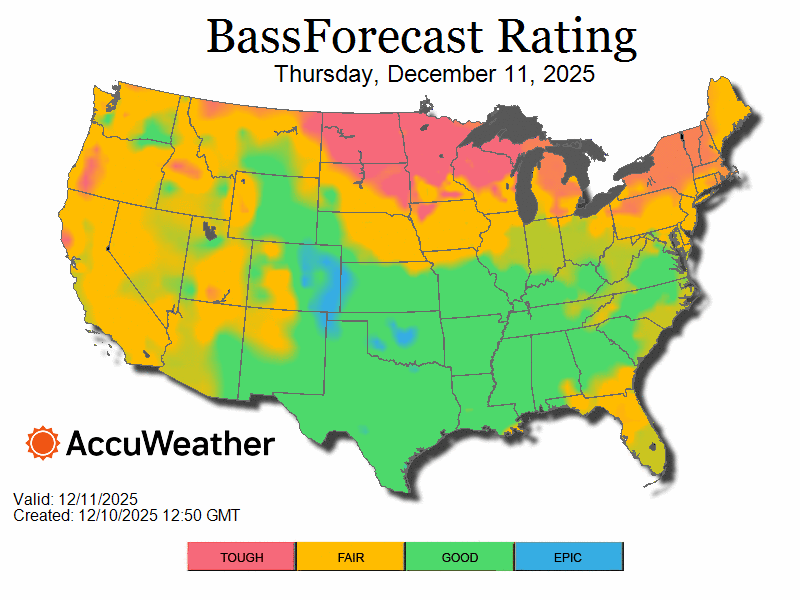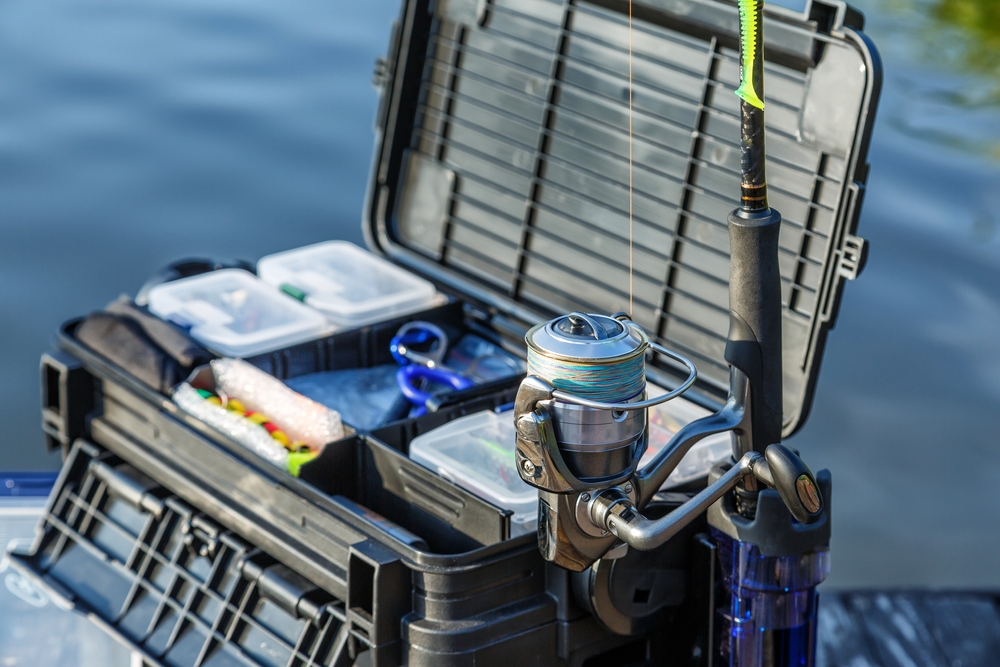Fishing Rod Materials Explained: Which is Right for You?
Share this article with every angler you know!
Usually, when we discuss rods, we talk about power, action, length, and the type of reel a rod is compatible with. From a performance standpoint, those factors tend to take center stage.
However, there is another factor that dramatically affects the performance of a rod that isn’t talked about nearly as much, and many beginners don’t even know about it. What’s the rod made of?
There are many different types of fishing rod materials, and today, we’re going to cover the ones you’re actually likely to see in the modern world.
We’ll go over what each material is, their strengths and weaknesses, and who is type of rod material is right for you.
Let’s get started.
Get notified of new bass fishing articles, tips and tricks!
Newsletter Signup
An Overview of the 4 Common Rod Materials
Many materials have been used over the centuries to make fishing rods, but in the modern fishing world, you’re only likely to see 4. Three of them are modern rod materials, and one is a traditional material that has managed to stick around since the beginning of fishing.
Before we break each one down, here’s a brief introduction.
1: Bamboo
There’s no need to talk about this one much. You will mostly see it in very cheap pole rods and exquisite, hand-crafted, poles. They’re not used much anymore, but they do provide a unique fishing experience, and you can find pole-style rods made of bamboo in most big-box stores and general tackle shops.
2: Fiberglass
Often found on cheaper rods, fiberglass is a common modern material that you likely have experience with even if you don’t know it. Just because it’s often the preferred material for budget-friendly rods doesn’t mean it lacks quality, either.
A fiberglass rod that is made properly can be an amazing choice. We’ll talk more about that later.
3: Graphite
Graphite can be found in rods from the mid-range to the high-range ends of the pricing spectrum. It provides a lot of advantages, but it also requires special care.
One thing to note is that graphite is often called “carbon fiber” by the fishing community. If you see a “carbon fiber” rod, just know it’s made of graphite.
4: Composite
Finally, there are rods known as “composite” rods. These are essentially hybrids that use both fiberglass and graphite to achieve fine-tuned rod action and combine the traits of both main rod types.
Usually, these rods are more expensive, but you can find them in the mid-range with options like modern UglyStikz.
The Pros and Cons of Each Rod Material
Each material behaves dramatically differently, and each one has its pros and cons. To figure out which one is going to be best suited to your technique and the situations you find yourself in, we’ve put together a full breakdown of each one’s notable pros and cons.
1: The Pros and Cons of Bamboo
Again, you’re not likely to use this unless you get into old-school pole fishing. So, there’s not much to say.
However, the primary benefit of a bamboo pole is that it’s extremely cheap, and there’s a sort of classic charm to it that every angler is sure to appreciate.
This does break fairly easily when you buy a cheap option, and you won’t find it on anything but pole-style rods. So, again, it’s a niche material, and you mostly buy one to enjoy a quiet evening fishing for bluegill and crappie.
2: The Pros and Cons of Fiberglass Rods
Fiberglass is often chosen for lower and mid-range rods for two reasons.
First, it’s a very cost-effective material. It’s cheaper to source and it’s easier to turn into a rod without nitpicking over the finest details. That helps keep budget-friendly rods low in price without creating abysmal products.
On top of the lower cost of manufacturing fiberglass rods, they’re also extremely durable. These aren’t the types of rods that are going to snap in half because you accidentally smack a tree while casting, kids aren’t going to immediately destroy them, and you should be able to have a decent rod for the rest of your life without trying too hard to take care of it.
However, that comes at a price. Mostly, fiberglass rods lack sensitivity. They tend to be very whippy, and when you’re dealing with light-biting fish, you can end up missing a ton of bites because your rod tip is whipping around like a CB antenna on a 90s pickup truck.
That doesn’t mean that you can’t feel anything, but there are situations where the fish bite extremely lightly.
That high level of flexibility also makes it more difficult to work with very subtle presentations. Since the rod flexes so much, you have to overcompensate with your movements to get the lure to move how you want it, and it’s easy to overdo it.
This flexibility can be compensated for by adjusting the taper of the rod during manufacturing, and that’s often done with higher-quality fiberglass rods, but if you buy a cheap one, expect it to be less useful for finesse purposes.
3: The Pros and Cons of Graphite Rods
Graphite is a premium material in most situations. It has an incredibly high tensile strength and can bend like crazy, but it’s still extremely sensitive toward the end of its taper. With a well-made graphite rod, you can detect the most subtle bites, create the smallest lure movements for extremely subtle presentations, and more.
The stiffness in the thicker end of the taper combined with a more sensitive tip also helps with casting to an extent. You don’t lose energy due to the rod bending and whipping all over the place.
However, there is a major downside to graphite. A graphite rod needs to be kept in perfect condition. It has a remarkable tensile strength, but if there is even a slight crack in the rod, it will snap with ease.
Unfortunately, a graphite rod is so prone to snapping due to small imperfections that most anglers don’t even know there’s damage to worry about. Mistreating your rod while hastily unhooking a fish, stepping on your rod, or any of that can put a micro fissure in the rod, and when you get locked into a bass fight, the whole thing snaps in half.
On top of that, repairing the rod isn’t usually a great option. You can get away with fixing a fiberglass rod until you buy another, but graphite usually splinters, and it will continue to snap.
4: The Pros and Cons of Composite Rods
A composite rod is essentially a jack-of-all-trades. Manufacturers cleverly mix both fiberglass and graphite materials to create a rod that combines the traits of both materials.
This is great in some ways and not as impressive in others.
The primary pro for composite rods is that you get the best of both worlds. You can enjoy a very sensitive rod that can pick up subtle bites well, but you don’t have to worry as much about big bass snapping the rod in half.
This allows you to use a composite rod for almost every strategy you can think of, and you can use the same rod to target a large variety of species without worrying about whether your rod is going to perform well enough to be successful.
However, like most all-around options, none of those benefits are quite as noticeable as they would be in a specialized rod. A graphite rod is always going to be lighter and more sensitive, and a fiberglass rod is always going to be stronger.
Composite rods are also harder to manufacture, and that means they’re often not found at the lower end of the price spectrum. You can find some in the mid-range, but most often, you should expect to pay decent money for one that is made well.
Which Rod Material is Best for You?
Each of these rods is going to fit a different style of fishing better than others, and your personal preferences and budget are also important factors to consider.
We’re going to give recommendations for the three primary rod materials to help point you toward the right choice for you. Bamboo and other novelty rods are so niche that they’re mostly for people who want a specific experience.
Who Should Buy a Composite Rod?
A composite rod is the best option for 3 types of anglers.
First, beginners who can put together a decent budget should definitely try to buy a composite rod. If you choose a medium power rod, you’ll be able to use your first rod to explore a wide variety of fishing techniques and targets without having to immediately purchase different rod setups.
Another reason to get one is if you often find yourself trying to squeeze a fishing trip into your day whenever possible. Not everyone can set aside entire day trips to catch some bass, and if you’re limited to stopping by a local pond after work, checking out small spots you happen to drive past, or otherwise fishing when you can, the all-around performance of a composite rod is desirable.
You can toss one rod and a small tackle box in your vehicle, stop whenever you want, and catch a few bass, bluegill, catfish, or anything else effectively.
Finally, a composite rod is perfect if you want to enjoy the sensitivity of a graphite rod but don’t want to treat your rod like fine jewelry. A composite rod is a lot more durable, but it’s still sensitive enough to pick up on very light bites. It can also be a great way to explore the possibility of buying a graphite rod without fully committing to it.
Who Should Buy a Fiberglass Rod?
There are 3 people who will benefit greatly from a fiberglass rod.
First, children almost have to have a fiberglass rod. You don’t want to buy a nice graphite rod, give it to a child, and then they break it after two days. Stick with a fiberglass rod, teach them how to use it properly and respect it, and maybe later, they can upgrade to a more sensitive graphite rod. A child also likely doesn’t have the skills to truly take advantage of a graphite rod.
Then, anglers who exclusively want to fight giant bass should have one. Fiberglass is more durable, and you’re more likely to successfully pull in a record-breaking bass with one than you are with a more delicate graphite rod.
Finally, it’s really something any serious angler should have. You will find yourself in situations where a fiberglass rod is optimal for the application. If you’re going to have a collection of rods, you might as well have a nice fiberglass rod for when you want to take on big fish and sensitivity isn’t an issue.
Who Should Buy a Graphite Rod?
You should get one if you really enjoy more subtle approaches to fishing or plan to target fish that aren’t as aggressive as bass. The sensitivity is truly something to behold, and you will love being able to feel the slightest bluegill or trout nibbles, every bump a bottom lure takes, and more. Just make sure you’re a responsible angler who takes care of your gear.
Bass Forecast Can Help Regardless of Which Rod You’re Using
One thing that’s more important than the material of the fishing rod you buy is the knowledge you possess, and we can help.
Whether you’re pole fishing with a $15 cane pole, or you’re targeting the next world-record largemouth bass, we can help you choose the best rod for bass fishing, provide real-time weather updates, maps of every waterway in the US, and much more to keep you on top of your game.
Download the Bass Forecast fishing app today.











-1739275914.jpg)
.png)
.png)